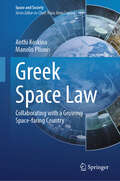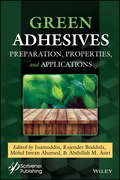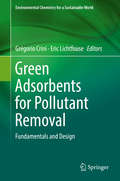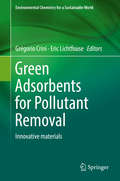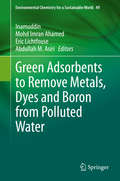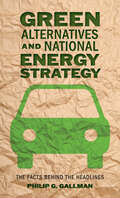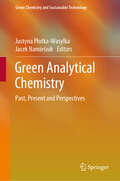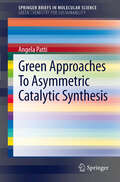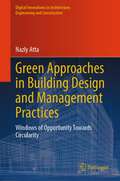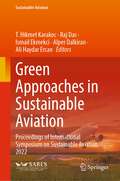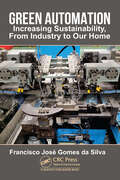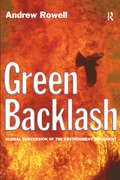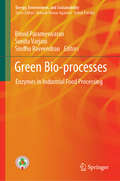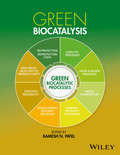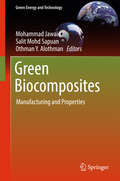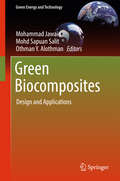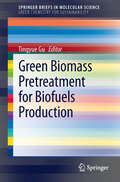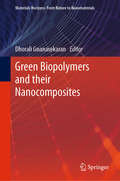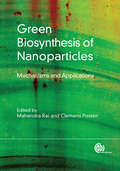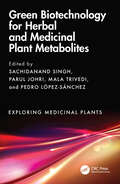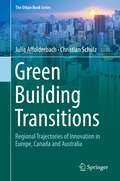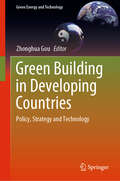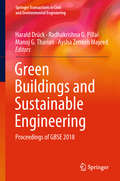- Table View
- List View
Greek Space Law: Collaborating with a Growing Space-faring Country (Space and Society)
by Manolis Plionis Anthi KoskinaThis book provides an overview of the Greek legislation applying to space activity under the responsibility of the Greek State, as in line with international space law. Greece is not an established space-faring country; however, it is showing particular dynamism, making the most of its participation in international and EU space endeavors. Indeed, along with outstanding achievements in space science Greece took legislative action both at the international and national levels (proposals at the UNCOPUOS; Greek space law; signing of the Artemis Accords). Hence, the time has come to refer to – and present aspects of – the Greek space legislation. After an introductory section, the book provides information first on the national laws providing for the Greek participation in international space systems and in EU activities, which could be regarded as being the initial steps of Greece in the context of space. Thereafter, the rules applying to Greek space activity per se are presented, focusing on the authorities competent to decide on space matters, then on the substantial law rules allowing for – and clarifying – the application of international space law to domestic space operations. This book presents an overall view and analysis of the Greek space legislation, adding valuable information to the existing bibliography. Included as an appendix is a scholarly translation of the 2017 Greek space law.
Green Adhesives: Preparation, Properties, and Applications
by Inamuddin Abdullah M. Asiri Mohd Imran Ahamed Rajender BoddulaGreen Adhesives: Preparation, Properties and Applications deals with the fabrication methods, characterization, and applications of green adhesives. It also includes the collective properties of waterborne, bio, and wound-healing green adhesives. Exclusive attention is devoted to discussing the applications of green adhesives in biomedical coatings, food, and industrial applications.
Green Adsorbents for Pollutant Removal: Fundamentals and Design (Environmental Chemistry for a Sustainable World #18)
by Eric Lichtfouse Grégorio CriniThis is the first volume on adsorption using green adsorbents and is written by international contributors who are the leading experts in the adsorption field. The first volume provides an overview of fundamentals and design of adsorption processes. For people who are new to the field, the book starts by two overview chapters presenting the principles and properties of wastewater treatment and adsorption processes. The book also provides a comprehensive source of knowledge on acid-base properties of biosorbents. It discusses fractal-like kinetic models for fluid-solid adsorption, reports on the chemical characterization of oxidized activated carbons for metal removal, and the use of magnetic biosorbents in water treatment. Furthermore, the thermodynamic properties of metals adsorption by green adsorbents, and biosorption of polycyclic aromatic hydrocarbons and organic pollutants are reviewed, and finally the recent trends and impact of nanomaterials as green adsorbent and potential catalysts for environmental applications are summarized. The audience for this book includes students, environmentalists, engineers, water scientists, civil and industrial personnel who wish to specialize in adsorption technology. Academically, this book will be of use to students in chemical and environmental engineering who wish to learn about adsorption and its fundamentals. It has also been compiled for practicing engineers who wish to know about recent developments on adsorbent materials in order to promote further research toward improving and developing newer adsorbents and processes for the efficient removal of pollutants from industrial effluents. It is hoped that the book will serve as a readable and useful presentation not only for undergraduate and postgraduate students but also for the water scientists and engineers and as a convenient reference handbook in the form of numerous recent examples and appended information.
Green Adsorbents for Pollutant Removal: Innovative materials (Environmental Chemistry for a Sustainable World #19)
by Eric Lichtfouse Grégorio CriniThis is the second volume on adsorption using green adsorbents and is written by international contributors who are the leading experts in the adsorption field. Together with the first volume they show a typical selection of green materials used in wastewater treatment, with emphasis on industrial effluents. This second volume focuses on innovative materials. It presents hemp-based materials for metal removal, and the use of leaves for metal removal. It describes the biosorption of metals and metalloids on various materials and discusses the recent advances in cellulose-based adsorbents used in environmental purposes. Furthermore, activated carbons from food wastes, aerogels and bones, and municipal solid waste biochar as efficient materials for pollutant removal, respectively are reviewed as well as biosorption of dyes onto microbial biosorbents and the use of mushroom biomass to remove pollutants are looked at. The volume also includes detailed review of green adsorbents for removal of antibiotics, pesticides and endocrine disruptors and the use of pillared interlayered clays as innovative materials for pollutant removal. Finally, the use of green adsorbents for radioactive pollutant removal from natural water is discussed. The audience for this book includes students, environmentalists, engineers, water scientists, civil and industrial personnel who wish to specialize in adsorption technology. Academically, this book will be of use to students in chemical and environmental engineering who wish to learn about adsorption and its fundamentals. It has also been compiled for practicing engineers who wish to know about recent developments on adsorbent materials in order to promote further research toward improving and developing newer adsorbents and processes for the efficient removal of pollutants from industrial effluents. It is hoped that the book will serve as a readable and useful presentation not only for undergraduate and postgraduate students but also for the water scientists and engineers and as a convenient reference handbook in the form of numerous recent examples and appended information.
Green Adsorbents to Remove Metals, Dyes and Boron from Polluted Water (Environmental Chemistry for a Sustainable World #49)
by Eric Lichtfouse Inamuddin Abdullah M. Asiri Mohd Imran AhamedThis book reviews adsorption techniques to clean wastewater, with focus on pollution by dyes and heavy metals. Advanced adsorbents include carbon nanomaterials, biomass, cellulose, polymers, clay, composites and chelating materials.
Green Alternatives and National Energy Strategy: The Facts behind the Headlines
by Philip G. GallmanIt is no secret that the United States’ dependence on oil—mostly foreign—puts the country in a precarious position. The United States needs innovative ways not only to power millions of automobiles on its highways but also to secure sustainable sources of fuel for the future. This book presents the latest facts and figures about alternative energy to any physicist, engineer, policymaker, or concerned citizen who needs a reliable source of information on the nation’s looming energy crisis. Philip G. Gallman focuses especially on green vehicles and the interrelationship between their design and various energy sources. He explains simply and clearly the complex energy and automotive engineering issues involved in developing green vehicles, measures their likely effect on energy resource demand, and considers what they might mean for national energy strategy. Addressing problems associated with renewable resources often overlooked or ignored in the popular press, Gallman explains what replacing oil with alternative sources of energy realistically entails. Can the nation satisfy its energy demands with wind turbines, solar power, hydroelectric power, or geothermal power? Is biodiesel or electricity the answer to our gas-guzzling ways? Organized logically and with an accessible narrative, Green Alternatives and National Energy Strategy guides readers through the essential questions and hurdles the United States must answer and overcome to transition from a petroleum-dependent nation to one that runs on sustainable, renewable energy.
Green Analytical Chemistry: Past, Present and Perspectives (Green Chemistry and Sustainable Technology)
by Justyna Płotka-Wasylka Jacek NamieśnikThe book explains the principles and fundamentals of Green Analytical Chemistry (GAC) and highlights the current developments and future potential of the analytical green chemistry-oriented applications of various solutions. The book consists of sixteen chapters, including the history and milestones of GAC; issues related to teaching of green analytical chemistry and greening the university laboratories; evaluation of impact of analytical activities on the environmental and human health, direct techniques of detection, identification and determination of trace constituents; new achievements in the field of extraction of trace analytes from samples characterized by complex composition of the matrix; “green” nature of the derivatization process in analytical chemistry; passive techniques of sampling of analytes; green sorption materials used in analytical procedures; new types of solvents in the field of analytical chemistry. In addition green chromatography and related techniques, fast tests for assessment of the wide spectrum of pollutants in the different types of the medium, remote monitoring of environmental pollutants, qualitative and comparative evaluation, quantitative assessment, and future trends and perspectives are discussed. This book appeals to a wide readership of the academic and industrial researchers. In addition, it can be used in the classroom for undergraduate and graduate Ph.D. students focusing on elaboration of new analytical procedures for organic and inorganic compounds determination in different kinds of samples characterized by complex matrices composition.Jacek Namieśnik was a Professor at the Department of Analytical Chemistry, Gdańsk University of Technology, Poland. Justyna Płotka-Wasylka is a teacher and researcher at the same department.
Green Approaches To Asymmetric Catalytic Synthesis
by Angela PattiNowadays, chirality is widely accepted as an important factor in molecular recognition processes and the biological activity of many pharmaceutical drugs and agrochemicals; this is confirmed by the continuous need for synthetic methods which lead to single or enriched enantiomers of such compounds. By presenting a review of the various and more recently developed approaches for both metal-transition and organocatalysis, this volume describes the development of "greener" asymmetric reactions which preserve stereoselectivity. The author summarizes the impressive amount of research that has been gathered within this field into three chapters focusing on: i)the search of alternative catalysts, ii) alternative solvents, and iii) alternative synthetic strategies and processes. For each topic, the fundamentals and some valuable applications are discussed.
Green Approaches in Building Design and Management Practices: Windows of Opportunity Towards Circularity (Digital Innovations in Architecture, Engineering and Construction)
by Nazly AttaThis book examines green transition and circular economy in the fields of building design and Real Estate management. By outlining windows for seizing the opportunity to integrate circular approaches in current building practices, the book provides information tools to support building stakeholders (e.g. building designer and managers, manufacturers, Real Estate owners, maintenance operators, facility managers, etc.) in: (i) understanding circular re-strategies (e.g. reuse, remanufacturing, repurposing, etc.), the related requirements and the pre-conditions for their implementation within building design and management practices; (ii) reviewing design approaches at the product and building scale, also highlighting new circularity-related contents for the Briefing Documents; (iii) developing circular organizational and contract models for the procurement of Facility Management services, also integrating new circularity-related contents in Invitations to Tenders (ITTs); and (iv) assessing the quality and the effectiveness of circular practices, also highlighting circularity performance metrics and indicators in the context of corporate sustainability reporting.
Green Approaches in Sustainable Aviation: Proceedings of International Symposium on Sustainable Aviation 2022 (Sustainable Aviation)
by T. Hikmet Karakoc Alper Dalkiran Ali Haydar Ercan Ismail Ekmekci Raj DasSustainable aviation is a long-term strategy to provide innovative solutions to the industry’s environmental challenges. The International Symposium on Sustainable Aviation is a multi-disciplinary symposium that presents research on current sustainability-based issues and future trends in aviation from an economic, social, and environmental perspective. The conference provides a platform offering insights on a broad range of current issues in aviation, such as aviation and environment, commercial air transport, regulations and policy, sustainable aerospace vehicles and technologies, and environmental modeling and measurements. The ISSA symposium allows researchers, scientists, engineers, practitioners, policymakers, and students to exchange information, present new technologies and developments, and discuss future direction, strategies, and priorities in sustainable aviation topics.
Green Automation: Increasing Sustainability, From Industry to Our Home
by Francisco José Gomes da SilvaEnvironmental issues are a growing concern for our society, and should deserve increased attention, given the extremely negative climate changes which have been taking place. Emissions of greenhouse gases, excessive dependence on fossil fuels, growing consumption of power energy, and exacerbated consumption of materials are some of the problems that need to be addressed urgently. Some of these problems can be overcome through ingenious solutions based on automation. This book aims to make a contribution precisely in this sense, criticizing the current state of society in general and providing some solutions that can be used as a basis for the development of more environmentally friendly systems.
Green Backlash: Global Subversion of the Environment Movement
by Andrew RowellThe tide is turning against environmentalism as the political right, industry and governments fight back. Green Backlash is a controversial expose of the anti-environmental movement. Tracing the rise of the backlash from the Wise Use movement in the USA, the author reveals its rapid spread worldwide: the anti-roads movement in the UK, forestry debates in Canada and Australia, marine resource issues in Europe, South-East Asia, and controversies such as the Brent Spar. The backlash is set to get worse as the resource wars intensify. This book offers a greater understanding of the challenges and threats facing global environmentalism, concluding that the environmental movement now has a chance to re-evaluate and change for the better to beat the backlash - a chance that must not be missed.
Green Bio-processes: Enzymes in Industrial Food Processing (Energy, Environment, and Sustainability)
by Binod Parameswaran Sunita Varjani Sindhu RaveendranThis volume discusses recent advancements to the age old practice of using microbial enzymes in the preparation of food. Written by leading experts in the field, it discusses novel enzymes and their applications in the industrial preparation of food to improve taste and texture, while reducing cost and increasing consistency. This book will be of interest to both researchers and students working in food technology.
Green Biocatalysis
by Ramesh N. PatelGreen Biocatalysis presents an exciting green technology that uses mild and safe processes with high regioselectivity and enantioselectivity. Bioprocesses are carried out under ambient temperature and atmospheric pressure in aqueous conditions that do not require any protection and deprotection steps to shorten the synthetic process, offering waste prevention and using renewable resources. Drawing on the knowledge of over 70 internationally renowned experts in the field of biotechnology, Green Biocatalysis discusses a variety of case studies with emphases on process R&D and scale-up of enzymatic processes to catalyze different types of reactions. Random and directed evolution under process conditions to generate novel highly stable and active enzymes is described at length. This book features: A comprehensive review of green bioprocesses and application of enzymes in preparation of key compounds for pharmaceutical, fine chemical, agrochemical, cosmetic, flavor, and fragrance industries using diverse enzymatic reactions Discussion of the development of efficient and stable novel biocatalysts under process conditions by random and directed evolution and their applications for the development of environmentally friendly, efficient, economical, and sustainable green processes to get desired products in high yields and enantiopurity The most recent technological advances in enzymatic and microbial transformations and cuttingedge topics such as directed evolution by gene shuffling and enzyme engineering to improve biocatalysts With over 3000 references and 800 figures, tables, equations, and drawings, Green Biocatalysis is an excellent resource for biochemists, organic chemists, medicinal chemists, chemical engineers, microbiologists, pharmaceutical chemists, and undergraduate and graduate students in the aforementioned disciplines.
Green Biocomposites
by Mohammad Jawaid Othman Y. Alothman Salit Mohd SapuanThis book addresses different aspects of green biocomposite manufacture from natural fibres and bioplastics, including the manufacturing procedures and the physical, mechanical, thermal and electrical properties of green biocomposites. Featuring illustrations and tables that maximize reader insights into the current research on biocomposites, it emphasises the role of green technology in the manufacture of biocomposites and analysis of properties of biocomposites for different applications. It is a valuable resource for researchers and scientists in industry wanting to understand the need for biocomposites in the development of green, biodegradable and sustainable products for different applications.
Green Biocomposites
by Mohd Sapuan Salit Mohammad Jawaid Othman Y. AlothmanThis book introduces the concept, design and application of green biocomposites, with a specific focus on the current demand for green biocomposites for automotive and aerospace components. It discusses the mathematical background, innovative approaches to physical modelling, analysis and design techniques. Including numerous illustrations, tables, case studies and exercises, the text summarises current research in the field. It is a valuable reference resource for researchers, students and scientists working in the field of materials science.
Green Biomass Pretreatment for Biofuels Production
by Tingyue GuThe increasing global demand for energy requires a versatile approach, prompting many researchers to focus on renewable bioenergy from different biomasses, especially cellulosic biomass. Such biomasses can be agricultural wastes, municipal wastes or direct harvests from high-yield energy corps. If properly pre-treated, the subsequent enzyme hydrolysis step is much more effective and can effectively minimises the waste disposal. Green Biomass Pretreatment for Biofuels Production reviews a range of pretreatment methods such as ammonium fiber explosion, steam explosion, dilute acid hydrolysis, alkali hydrolysis, and supercritical carbon dioxide explosion focusing on their final sugar yields from hemicellulose, glucose yields from cellulose, as well as on their feasibilities in bioenergy production processes at various scales. This book emphasises the tactical mobile and on-farm scales applications that use green pretreatments and processing technologies without the need of on-site waste treatment. Because of the varieties of different biomasses, no single pretreatment is expected to be the universal choice. Some of the pretreatment methods present niche applications are also discussed.
Green Biopolymers and their Nanocomposites: A Review On Versatile Applications Of Biodegradable Polymers (Materials Horizons: From Nature to Nanomaterials)
by Dhorali GnanasekaranThis book comprises a collection of chapters on green biopolymer nanocomposites. The book discusses the preparation, properties, and applications of different types of biodegradable polymers. An overview of recent advances in the fabrication of biopolymers nanocomposites from a variety of sources, including organic and inorganic nanomaterials, is presented. The book highlights the importance and impact of eco-friendly green nanocomposites, both environmentally and economically. The contents of this book will prove useful for students, researchers, and professionals working in the field of nanocomposites and green technology.
Green Biosynthesis of Nanoparticles: Mechanisms and Applications
by Mahendra Rai Hassan Hassan Katerina Rosenbergová Sebastian D Sebastian D Thoms Thoms Ali Mumtaz Kelvii Wei Kelvii Wei Andrea Andrea Dennis A Dennis A Nikolay Nikolay Arfan Arfan Martín A Martín A K K Ahmad Reza Ahmad Reza Elias Elias Muniyandi Muniyandi Siavash Siavash Afolake Temitope Afolake Temitope Kateryna Kateryna Julio Julio Katerina Horská Muralidharan Muralidharan Clemens Posten Lena-Maria Lena-Maria Anal K Anal K Zygmunt Zygmunt Markéta Markéta Jirí Slabotinský Adam Adam Nelson Nelson María I María I Yvonne Nemcová Aileen Aileen Sangiliyandi Sangiliyandi Kevin John Kevin John Christopher T Christopher T Gerald GeraldThere are physical and chemical methods of synthesis of nanomaterials. But due to the damage caused by these methods to the environment there is a pressing need of green nanotechnology, which is a clean and eco-friendly technology for the development of nanomaterials. The present book includes green synthesis of nanoparticles by algae, diatoms and plants. The mechanism behind the synthesis of nanoparticles will also be discussed. The book would be a valuable resource for students, researchers and teachers of biology, chemistry, chemical technology, nanotechnology, microbial technology and those who are interested in green nanotechnology.
Green Biosynthesis of Nanoparticles: Mechanisms and Applications
by Hassan Hassan Katerina Rosenbergová Sebastian D Sebastian D Thoms Thoms Ali Mumtaz Kelvii Wei Kelvii Wei Andrea Andrea Dennis A Dennis A Nikolay Nikolay Arfan Arfan Martín A Martín A K K Ahmad Reza Ahmad Reza Elias Elias Muniyandi Muniyandi Siavash Siavash Afolake Temitope Afolake Temitope Kateryna Kateryna Julio Julio Katerina Horská Muralidharan Muralidharan Lena-Maria Lena-Maria Anal K Anal K Zygmunt Zygmunt Markéta Markéta Jirí Slabotinský Adam Adam Nelson Nelson María I María I Yvonne Nemcová Aileen Aileen Sangiliyandi Sangiliyandi Kevin John Kevin John Christopher T Christopher T Gerald GeraldThere are physical and chemical methods of synthesis of nanomaterials. But due to the damage caused by these methods to the environment there is a pressing need of green nanotechnology, which is a clean and eco-friendly technology for the development of nanomaterials. The present book includes green synthesis of nanoparticles by algae, diatoms and plants. The mechanism behind the synthesis of nanoparticles will also be discussed. The book would be a valuable resource for students, researchers and teachers of biology, chemistry, chemical technology, nanotechnology, microbial technology and those who are interested in green nanotechnology.
Green Biotechnology for Herbal and Medicinal Plant Metabolites (Exploring Medicinal Plants)
by Sachidanand Singh, Parul Johri, Mala Trivedi, and Pedro López-SánchezGreen Biotechnology for Herbal and Medicinal Plant Metabolites presents an innovative approach that leverages plant-derived molecules for agriculture, medicine, and wellness in pursuit of sustainable health solutions. This comprehensive guide delves into the latest advancements in green biotechnology, showcasing in vitro, genetic, and biochemical strategies for enhancing the yield and potency of essential metabolites in medicinal plants. Designed to appeal to researchers, practitioners, and students alike, the book provides a balanced view of bioengineering plant metabolites’ medicinal, economic, and environmental benefits. It illustrates how the potential of green biotechnology can unlock new frontiers in natural products, paving the way for innovative treatments and sustainable healthcare solutions.The book explains how green biotechnology facilitates the sustainable extraction of plant secondary metabolites. Each chapter emphasizes the need to leverage eco-friendly technologies in metabolite extraction to maximize the benefits and opportunities provided by an integrative, risk-based approach to innovation, aligned with the Sustainable Development Goals. Additionally, the book underscores the role of bioinformatics tools in streamlining real-world solutions, helping to navigate the complexities of wet-lab experimentation with more uncertainties, interdependencies, and unforeseen risks.Salient Features:• Thoroughly explores the potential benefits of green biotechnology.• Gives deep insight into the extraction strategies of plant metabolites.• Chapters are designed in a way that provides comprehensive details on the industrial application of bio-compounds.• Provides a comprehensive summary of the most recent findings in plant metabolite and green biotechnology.Researchers working on green biotechnology for medicinal and herbal plants will undoubtedly find this book useful for developing a thorough understanding of the most recent developments and instruments in this field. The book can also be used as a thorough textbook for graduate-level classes in biomedical, health, and food and nutrition sciences. The book is a collection of chapters contributed by experts in medicinal plants.
Green Buddhism: Practice and Compassionate Action in Uncertain Times
by Stephanie KazaAt a time of growing environmental crisis, a pioneer of Green Buddhist thought offers challenging and illuminating perspectives.With species rapidly disappearing and global temperatures rising, there is more urgency than ever to act on the ecological crises we face. Hundreds of millions of people around the world—including unprecedented numbers of Westerners—now practice Buddhism. Can Buddhists be a critical voice in the green conversation? Leading Buddhist environmentalist Stephanie Kaza has spent her career exploring the intersection of religion and ecology. With so much at stake, she offers guidance on how people and communities can draw on Buddhist concepts and practices to live more sustainable lives on our one and only home.
Green Building Transitions: Regional Trajectories Of Innovation In Europe, Canada And Australia (The Urban Book Series)
by Julia Affolderbach Christian SchulzThis volume analyzes sustainability-related innovations in the building sector and discusses how regional contexts articulate transition trajectories toward green building. It presents ‘biographies’ of drivers and processes of green building innovation in four case studies: Brisbane (AUS), Freiburg (GER), Luxembourg (LU), and Vancouver (CA). Two of them are relatively well known for their initiatives to mitigate climate change – particularly in the building sector, whereas the other two have only recently become more active in promoting green building. The volume places emphasis on development paths, learning processes, and innovations. The focus of the case studies is not restricted to purely technological aspects but also integrates regulatory, procedural, institutional, and other processes and routines and their influence on the variations of the building sector. The diversity of the selected case studies offer the reader the opportunity to gain a thorough understanding of how sustainability developments have unfolded in different city regions. Case study-specific catalogues of transition paths provide insights to inform policy debates and planning processes. The catalogues identify crucial innovations (technological, regulatory, etc.) and explain the factors and circumstances that have led to their success and broader acceptance in Freiburg, Vancouver, Luxembourg, and Brisbane. With the help of a number of micro case studies within each of the four city regions, the case studies also offer ground for comparison and identification of differences. The book represents the outcome of the GreenRegio project, which stands for ‘Green building in regional strategies for sustainability: multi-actor governance and innovative building technologies in Europe, Australia, and Canada.’ GreenRegio is a 3-year CORE-INTER research project funded by the National Research Fund Luxembourg (lead) and the University of Cologne, and this volume is co-authored by the project’s principal investigators and project coordinator.
Green Building in Developing Countries: Policy, Strategy and Technology (Green Energy and Technology)
by Zhonghua GouThe book reveals how green buildings are currently being adapted and applied in developing countries. It includes the major developing countries such as China, Indonesia, Malaysia, Thailand, Pakistan, Cambodia, Ghana, Nigeria and countries from the Middle East and gathers the insights of respected green building researchers from these areas to map out the developing world’s green building revolution. The book highlights these countries’ contribution to tackling climate change, emphasising the green building benefits and the research behind them.The contributing authors explore how the green building revolution has spread to developing countries and how national governments have initiated their own green building policies and agendas. They also explore how the market has echoed the green building policy, and how a business case for green buildings has been established. In turn, they show how an international set of green building standards, in the form of various techniques and tools, has been incorporated into local building and construction practices. In closing, they demonstrate how the developing world is emerging as a key player for addressing the energy and environmental problems currently facing the world.The book helps developers, designers and policy-makers in governments and green building stakeholders to make better decisions on the basis of global and local conditions. It is also of interest to engineers, designers, facility managers and researchers, as it provides a holistic picture of how the industry is responding to the worldwide call for greener and more sustainable buildings.
Green Buildings and Sustainable Engineering: Proceedings of GBSE 2018 (Springer Transactions in Civil and Environmental Engineering)
by Harald Drück Radhakrishna G. Pillai Manoj G Tharian Aysha Zeneeb MajeedThis book comprises the proceedings of the International Conference on Green Buildings and Sustainable Engineering (GBSE 2018), which focused on the theme “Transforming our Built Environment through Innovation and Integration towards a Smart and Sustainable Future”. The papers included address all aspects of green buildings and sustainability practices in civil engineering, and offer a valuable reference resource for researchers, practitioners, and policy makers.
